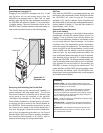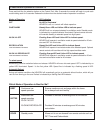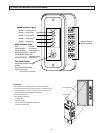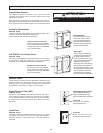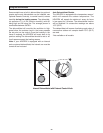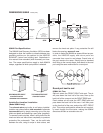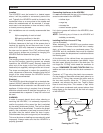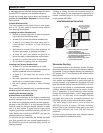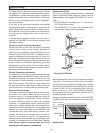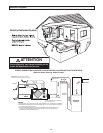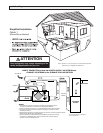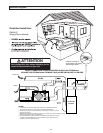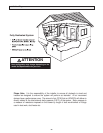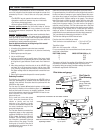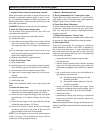
24
In homes without a forced air furnace, fresh air should
be supplied to all bedrooms and living areas, exclud-
ing bathrooms, kitchen and utility areas. It should be
supplied from high wall or ceiling locations. Grilles that
diffuse the air comfortably such as the Techgrille™
are recommended.
If the floor is the only option available, then special
care should be taken in locating grilles. Areas such as
under baseboard heaters will help to temper the air.
Also optional inline duct heaters are available for
mounting in the supply duct work to add heat if
required.
In homes with a forced air furnace, you may want to
connect the HRV/ERV to the furnace ductwork (see
information below).
Direct Connection to Furnace Ductwork
Should you wish to hard duct the supply air directly
into the cold air return of the furnace, remember to
check the air flow balance of the HRV/ERV with the
furnace fan both "ON" and "OFF" to determine that it
does not imbalance the unit more than 10%. Also, it is
advisable to include a short length of fabric flex duct or
other non-metallic connector in this hard ducted line in
order to keep the HRV/ERV separately grounded
(electrically) from the furnace. This will avoid a possi-
ble shock hazard to service people if a short to ground
develops in one of the devices.
Indirect Connection to Ductwork
If permitted by local codes, an indirect connection may
be made between the HRV/ERV supply duct and the
furnace return plenum. The fresh air from the unit may
be directed at a grille installed in the cold air return
duct of the furnace. The fresh air supply outlet from
the unit should be no closer than 4 inches (100 mm)
and no more than 12 inches (300 mm) from the grille.
Stale Air Exhaust System
The stale air exhaust system is used to draw air from
the points in the house where the worst air quality
problems occur. It is recommended that return air
ducts are installed in the bathroom, kitchen, and laun-
dry room. Additional return air ducts from strategic
locations (i.e. greenhouse, atrium, swimming pool,
sauna, etc.) may be installed. Also, the furnace return
duct may be used to exhaust from. In this method, the
exhaust air is not ducted back to the HRV/ERV with
"dedicated lines" from bathrooms, kitchens, etc.
Instead, the exhaust air is drawn out of the cold air
return of the forced air furnace. This method has
become popular and provides good ventilation when
installed in accordance with the instructions. The fur-
nace blower must be running when the unit is
operating for this system to be effective.
Dampers and Grilles
The use of balancing dampers and/or adjustable
grilles to balance the flow rates into various rooms is
recommended. We suggest TECHGRILLE™ air dif-
fusers.
• The TECHGRILLE™ is available in 4", 5", 6" and 8" (100,
125, 150 and 200 mm) sizes.
• The TECHGRILLE™ is a round, fully adjustable grille,
which provides superior, quiet air distribution.
We recommend the use of high mounted wall returns
with grilles. The exhaust air duct from the kitchen
should never be connected to a range hood. Instead,
the exhaust grille should be mounted high on the wall
at least 4 feet (1.2 m) horizontally away from the
stove. A "flip-up", 6" X 10" (150 X 250 mm) rectangu-
lar kitchen grille with removable grease filter is
available (Part No. 10-002).
Dampers should be located just prior to the HRV/ERV
to balance the stale air exhausted out of the house
with a fresh
air supply
entering the
house.
Techgrille Air Diffusers
Kitchen Grille
Removable
filter
Supply Air Ducting



